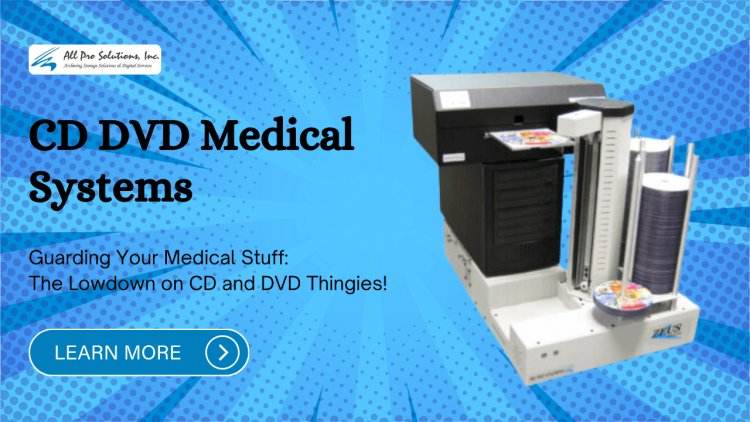Data Security: Impact of CD DVD Medical DICOM Publishing Systems
Data security is paramount, especially in the healthcare sector where sensitive patient information is constantly being generated and shared.
Share this Post to earn Money ( Upto ₹100 per 1000 Views )

Data security is paramount, especially in the healthcare sector where sensitive patient information is constantly being generated and shared. Medical imaging, in particular, generates large amounts of data that need to be securely stored, accessed, and shared.
DICOM (Digital Imaging and Communications in Medicine) has become the standard for managing medical imaging data, and the DICOM publishing system plays an important role in ensuring the security and integrity of this data.
DICOM publishing systems include a range of technologies and tools designed to publish medical images on CD or DVD for storage, sharing and distribution.
These systems typically include DICOM CD/DVD burners, disc publishers, and robotic systems that automate the burning and labelling of discs. Although these technologies provide convenience and efficiency, they also present unique challenges and considerations when it comes to data security.
Understanding DICOM Medical Services
DICOM medical services refers to the suite of protocols, standards, and technologies used to manage, store, and disseminate medical imaging data. These services enable healthcare providers to capture, store, and share medical images such as X-rays, MRIs, CT scans, and ultrasounds in a standardized format. By following DICOM standards, healthcare organizations ensure interoperability and compatibility across different imaging devices and systems.
Role of DICOM Publishers
DICOM publishers play a vital role in the workflow of medical imaging departments and healthcare organizations. These systems allow medical professionals to create CDs or DVDs containing DICOM images for patients, referring physicians, or for archival purposes. DICOM publishers often feature advanced capabilities such as automatic disc burning, printing of patient information and labels, and integration with PACS (Picture Archiving and Communication Systems) for seamless data transfer.
Security Challenges and Considerations
While DICOM publishing systems provide convenience and efficiency, they also present security challenges that must be addressed. Here are some key ideas:
Data Encryption: DICOM images contain sensitive patient information and must be encrypted to prevent unauthorized access. DICOM publishing systems must support encryption standards such as AES (Advanced Encryption Standard) to ensure data security during storage and transmission.
Access Control: Access to DICOM publishing systems should be limited to authorized personnel only. Role-based access control mechanisms should be implemented to limit user privileges and prevent unauthorized users from tampering with sensitive data.
Audit Trails: DICOM publishers must maintain detailed audit trails of all disc creation and distribution activities. These audit trails provide a record of who accessed the system, what actions were taken, and when they occurred, facilitating accountability and compliance with regulatory requirements.
Safe Disposal: Proper disposal of DICOM discs is essential to prevent data breaches. DICOM publishing systems must support secure disc erasure methods that ensure that data cannot be recovered when the disc is no longer needed.
Integration with PACS: Integration between DICOM publishing systems and PACS is essential for seamless data transfer and workflow automation. However, the security implications must be carefully considered, ensuring that data transmitted between systems is encrypted and protected from unauthorized access.
Compliance and Regulatory Requirements
Healthcare organizations must adhere to various compliance and regulatory requirements governing the security and privacy of patient data. Regulations such as HIPAA (Health Insurance Portability and Accountability Act) in the United States and GDPR (General Data Protection Regulation) in the European Union impose strict requirements for the protection of medical information. DICOM publishing systems must follow these rules to avoid legal consequences and protect patient confidence.
Best Practices for Secure DICOM Publishing
To reduce the security risks associated with DICOM publishing systems, healthcare organizations should implement the following best practices:
Regular Security Assessments: Perform regular security assessments and audits of DICOM publishing systems to identify weaknesses and vulnerabilities. Resolve any identified issues immediately to maintain data security.
Employee Training: Provide comprehensive training to employees using DICOM publishing systems to ensure they understand security protocols and best practices for handling sensitive data.
Encryption and Authentication: Implement strong encryption and authentication mechanisms to protect DICOM images from unauthorized access. Use multi-factor authentication where possible to increase security.
Vendor Selection: Choose DICOM publishing system vendors with a proven track record of prioritizing data security and compliance. Make sure the vendor provides regular updates and support to address emerging security threats.
Data Backup and Disaster Recovery: Implement robust data backup and disaster recovery strategies to ensure continuity of operations in the event of a security incident or system failure.
Conclusion
DICOM publishing systems play a vital role in the management and distribution of medical imaging data, but they also present unique challenges and considerations for data security.
By understanding these challenges and implementing best practices for secure DICOM publishing, healthcare organizations can protect sensitive patient information and maintain compliance with regulatory requirements. As technology continues to evolve, healthcare providers need to remain vigilant and proactive in protecting patient data from emerging threats.














